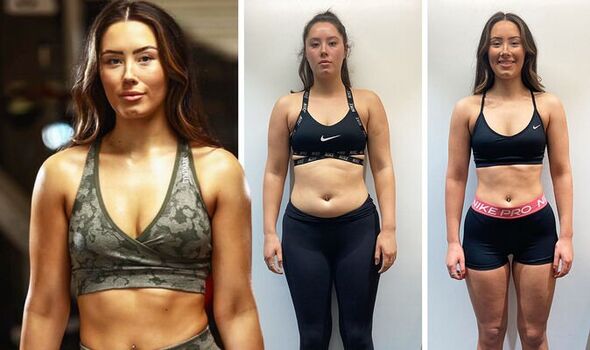
During the preteen years, children and adolescents experience a variety of physical, social, and cognitive changes. These changes can lead to children developing a negative view of their bodies. Research has also shown that eating disorders and depression are linked to poor body images. Young girls are often pressured to be thin and attractive to gain attention, and boys are sometimes made to feel unattractive and insecure by the media's portrayal of "real men."
A bad body image can lead some people to have unhealthy behaviors like dieting. Studies show that dieting can lead to mental and physical health problems in both boys and girls. Moreover, the negative impact of a poor body image on a person's self-esteem can also lead to an increase in the risk of suicide. It's important to address these issues at a young age. These expectations can lead to unrealistic beauty standards.

Although the relationship between body image and nutrition is complex, there are some proven benefits of CBCC on promoting healthy body images. The CBCC offers parents information and resources on healthy eating and exercise to help their children. This booklet can be downloaded for free and is a great place to start. This fact sheet includes several suggestions that will help you support your child’s healthy eating habits and body image. A PDF copy of the CBCC material can be downloaded, along with information on the program's benefits.
It's crucial to understand how nutrition and body image relate. Dancers can fall prey to the temptation of comparing their bodies to teachers' ideals. This can lead you to having a negative body image and low self-esteem. People who have a positive body image may make better food choices. So, if you're worried about the connection between nutrition and your child's body image, don't wait any longer. You should be aware of the warning signs of disordered consuming.
Since years, the relationship between nutrition to body image has been well researched. It is important to understand the relationships between the two. What you think of yourself is the most important thing. It isn't just about your appearance. Also, your mental well-being will suffer. Your body image will improve if you put more effort into your appearance. You can change your negative attitude about food by getting the right nutrients.

Although there's not a direct correlation between nutrition or body image, it is important for people to be aware of the impacts food has on their overall health. Teens are more likely to have eating disorders than adults. They can have devastating consequences on a girl's confidence and body. In addition, eating disorders are more prevalent in transgender and gender-identifying teenagers. These problems must be dealt with immediately.
FAQ
Exercise: Good or bad for immunity?
Exercise is good for your immune systems. When you exercise, your body produces white blood cells which fight off infections. Your body also removes toxins. Exercise can prevent diseases such as cancer and heart disease. Exercise also helps to reduce stress levels.
However, overtraining can damage your immune system. Your muscles can become sore if you exercise too much. This can lead to inflammation and swelling. In order to fight infection, your body must produce more antibodies. This can lead to allergic reactions and other autoimmune disorders.
So, don't overdo it!
How to measure body fat?
A Body Fat Analyzer can be used to measure body fat. These devices measure the body fat percentage in people who wish to lose weight.
What should you eat?
Get lots of fruits & vegetables. They provide vitamins and minerals to keep your immune system strong. They are also rich in fiber, which is good for digestion and makes fruits and vegetables filling. Try to include at least five servings of fruit and veg per day.
Water is essential for your body. Water flushes toxins out of the body and helps to feel full between meals. Drink about eight glasses each day.
Eat whole grains instead of refined ones. Whole grains contain all of their nutrients, including B vitamins and iron. Some nutrients have been removed from refined grains.
Sugary drinks are best avoided. Sugary drinks are high in empty calories and can lead to obesity. Instead, you can opt for water or milk, as well as unsweetened herbal teas.
Avoid fast food. Fast food is low in nutritional value. While it might taste good, it won't give your body the energy it needs to function properly. Use healthier options, such as soups, sandwiches, salads, and pasta.
Limit alcohol intake. Alcohol can lead to poor nutrition and empty calories. Limit your consumption to no more than 2 alcoholic beverages per week
Try to cut down on red meat. Red meats are high-in saturated fat and cholesterol. Choose lean cuts such as beef, pork and lamb, chicken, fish, or turkey.
What can you do if your immune system is weak?
The human body consists of trillions of cells. These cells work together to form organs and tissues that perform specific functions. One cell is replaced by another when it dies. The chemical signals known as hormones are used to communicate between cells. Hormones regulate all bodily processes, from growth and development to metabolism and immunity.
Hormones are chemicals secreted by glands throughout the body. They travel through the blood stream and act like messengers to control how our bodies function. Some hormones are made internally, while others are created outside the body.
When a hormone-producing gland releases their contents into the bloodstream, hormone production begins. Once released, hormones move through the body until they reach their target organ. Sometimes hormones stay active for only a short time. Other hormones stay active longer and continue to influence the body's functioning even after they leave the bloodstream.
Some hormones are made in large quantities. Some hormones are produced in large quantities.
Some hormones are only produced at certain times in your life. Estrogen is one example. It's produced in puberty, pregnancy and menopause. Estrogen assists women with breast development, bone density, and osteoporosis prevention. It also promotes hair growth and keeps skin smooth and soft.
How can I tell what is good for me?
You have to listen to what your body says. Your body will tell you how much exercise, nutrition, and sleep you need. Your body will tell you what to do so that you don't go overboard. Pay attention to your body, and ensure that you are doing all you can to keep yourself healthy.
How often should I exercise
Exercise is essential for maintaining a healthy lifestyle. There is no time limit on how much you should exercise. Finding something you enjoy is key. Stick with it.
When you exercise three times per week, aim for 20-30 minutes moderate intensity. Moderate intensity means you'll still be breathing hard after you've finished. This type of workout burns around 300 calories.
Walking is a great option if you are a keen walker. You can do 10-minute walks four days per week. Walking is easy on the joints and has low impact.
If you'd rather run, try jogging for 15 minutes three times a week. Running is a great way to burn off excess calories and build muscle tone.
You can start slow if you're new to exercise. Begin by only doing 5 minutes of cardio five times per week. Gradually increase the time you do cardio until your goal is reached.
What is the difference in calorie and kilocalories?
Calories refer to units that are used for measuring the energy in food. The unit of measurement is called a calorie. One calorie is the amount of energy required to heat one gram water one degree Celsius.
Kilocalories can also be used to refer to calories. Kilocalories equal one thousandth of a calorie. 1000 calories, for example, equals one kilocalorie.
Statistics
- WHO recommends reducing saturated fats to less than 10% of total energy intake; reducing trans-fats to less than 1% of total energy intake; and replacing both saturated fats and trans-fats to unsaturated fats. (who.int)
- The Dietary Guidelines for Americans recommend keeping added sugar intake below 10% of your daily calorie intake, while the World Health Organization recommends slashing added sugars to 5% or less of your daily calories for optimal health (59Trusted (healthline.com)
- According to the Physical Activity Guidelines for Americans, we should strive for at least 150 minutes of moderate intensity activity each week (54Trusted Source Smoking, harmful use of drugs, and alcohol abuse can all seriously negatively affect your health. (healthline.com)
- This article received 11 testimonials and 86% of readers who voted found it helpful, earning it our reader-approved status. (wikihow.com)
External Links
How To
What does the meaning of "vitamin?"
Vitamins are organic compounds found naturally in food. Vitamins help us absorb nutrients from foods we eat. Vitamins are not made by the body, so they must be obtained through food.
There are two types of vitamins: water soluble and fat soluble. Water-soluble vitamins dissolve quickly in water. Some examples include vitamin C,B1 and B2 vitamins (thiamine), B2 and riboflavin, B3 and B6 vitamins (niacin), folic acids, biotin, pantothenic acids, and cholesterol. Fat-soluble vitamins can be stored in the liver or in fatty tissue. These include vitamin D, E and K, as well as beta carotene.
Vitamins can be classified according to biological activity. There are eight main groups of vitamins.
-
A - Essential for healthy growth and health maintenance.
-
C - important for proper nerve function and energy production.
-
D - Essential for healthy teeth and bones.
-
E - Required for good vision & reproduction
-
K - Required for healthy nerves and muscles.
-
P - Essential for strong bones and teeth.
-
Q - aids digestion, absorption and absorption iron
-
R – Required for the formation of red blood vessels.
The recommended daily allowance (RDA), for vitamins, varies depending upon age, gender, or physical condition. The U.S. Food and Drug Administration, (FDA), sets the RDA value.
For adults aged 19 and older, the RDA for vitamin B is 400 micrograms daily. However, pregnant women need 600 micrograms per day because it is important for fetal development. Children ages 1-8 require 900 micrograms per day. Infants under one year of age require 700 micrograms per day, but this amount decreases to 500 micrograms per day between 9 months and 12 months of age.
Children between the ages 1--18 years old who are overweight or obese require 800 micrograms per Day, while those who are overweight or obese need 1000 micrograms. To meet their nutritional needs, children underweight and obese require 1200 micrograms a day.
Children ages 4-8 years who have been diagnosed with anemia need 2200 micrograms per day of vitamin C.
2000 micrograms is the minimum daily intake for adults over 50 years old to maintain good health. Breastfeeding or pregnant women require 3000 micrograms per daily due to higher nutrient demands.
Adults over 70 need 1500 micrograms daily, as they lose 10% of their muscle every ten years.
Women who are pregnant and lactating need more nutrients than the RDA. Pregnant woman need 4000 micrograms daily in pregnancy, and 2500 per day after childbirth. Breastfeeding moms need 5000 micrograms each day when breastmilk production occurs.